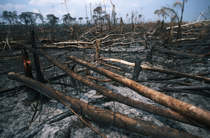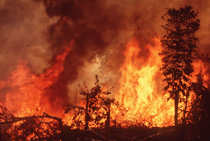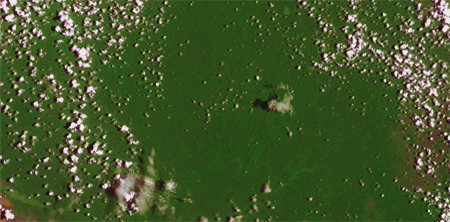3. Syndromes of Global Change
Land Clearance in the Tropics
Fire clearance and shifting cultivation are forms of land cultivation, which are especially prominent in the tropic and sub tropic forest areas. It is an area extensive cultivation shift, for which after a short while, because of the fast exhaustion of soil, new terrain must be sought after (Leser 2005).
From the almost three billion people, who inhabit rural regions worldwide and invest their livelihood in agriculture, an estimated 500 million people resort to shifting cultivation for sustenance. With the original form of agriculture in tropical forests, a relatively small piece of land will be cleared, partially by hand. Around the end of the dry period, the dead and still existent (trees) vegetation will be burned. The mineral-rich ashes serve as fertiliser, it is however only shortly available (Latz 2007).
Extra Material :
Land Clearance in Rondônia - precise observation of the three satellite images
Because the soil cannot absorb the minerals, the nutrients along with a thin organic layer will be washed out through heavy percipitation. Because of a decline in earnings, within a few years the farmer is forced to use a new plot for cultivation. The abandoned fields remain unused and after a few years, build a secondary forest. The biomass in this area is often only after ten to twelve years again able to produce enough top soil in order to use the area again for agricultural purposes (Latz 2007).

Carbonised Tree Trunks for a Cattle Ranch in Brazil
|

Fire Clearance in the Amazon |
Fire in this region is the most important instrument of land use change. Through fire clearance, the use of past forest areas for livestock breeding and logging has turned the once dense primary forest into a degraded, fragmented, and fire susceptible landscape. Especially for the widespread livestock breeding in South America large areas have been deforested and turned into pastures. The selective withdrawal of valuable wood types has the strongest negative effect on the surrounding forest areas, as, through the establishment of access paths in new, once untouched areas further deforestation has been made easy (Cochrane 2001, Eva, Lambin 2000, Goldammer 1997, Kollar 2006).
A huge disadvantage of this cultivation form are the enormous surface costs; the earnings are relatively low: in order to produce a tonne of crops, 300 tonnes of biomass must be destroyed. The traditional shifting cultivation is less harmful, because the remaining tree stumps and roots prevent ground erosion and through rash coppicing, secondary forests can easily form. In this case, it is more about forest degradation than deforestation. Through the growing population pressure down time has become shorter and the traditional shifting cultivation can no longer be sustainably perpetuated; through this, the meaning of fire clearance as an ecological means of cultivation falls to the wayside - alternative production forms will be necessary in the future (Scholz 2003).
Tasks:
1. Explain the changes of land use in the Rondônia region using the satellite images.
2a. Explain why these changes have occurred.
2b. Which roll has fire clearance played?
2c. Check your hypotheses using the texts.
3. Draft a future scenario for this region.
